Back in 8-bit days it was quite common for people to actually know the names of the individuals who made some of their favourite games (for back then many games were made entirely by individuals, before it became the huge-team-effort that it is today). These days you’re only likely to know the name of a game’s designer if they are egotistical enough to actually mention it in the title of their game.
On the Speccy you had the likes of your Matthew Smiths and Mike Singletons. On the Commodore you had your Andy Braybrooks and Tony Crowthers. There were quite a few well known names on each platform and you could generally be assured of getting what you were after if you liked the work of one of these fellows and then decided to pick up further games by the same person. It was a bit like following a favourite band, but with nerds.
But what of the Atari? Continuing my amble through the world of Atari 8-bits, today I’ll look at the A8 output of some people whose names I actually remember from those days. I’m not going to begin with the obvious like Doug Neubauer because he deserves an entire blog entry on his own which I shall hopefully get to one day. Here I’ll just examine the a8 output of a couple of chaps whose work I enjoyed, and who actually did more than one game on the system. I’m not saying these guys are the best of the best, just that their work impressed me enough back in the day that I remember their names even now. And their work is pretty consistent so it likely won’t be a waste of time to boot up and try any of the games I mention here.
Russ Wetmore
One has to feel sorry for poor Mr. Wetmore having had to go through school with a last name that sounds like one of those baby dolls with convincingly disgusting simulated bodily functions that some children seem to like (perhaps because they have only recently mastered voluntary control of said bodily functions themselves). I bet that can’t have been much fun. Nonetheless Russ Wetmore emerged from this unfortunate circumstance with sparkling Atari 8-bit programming skills which he put to good use in some excellent titles that are well worth a look.
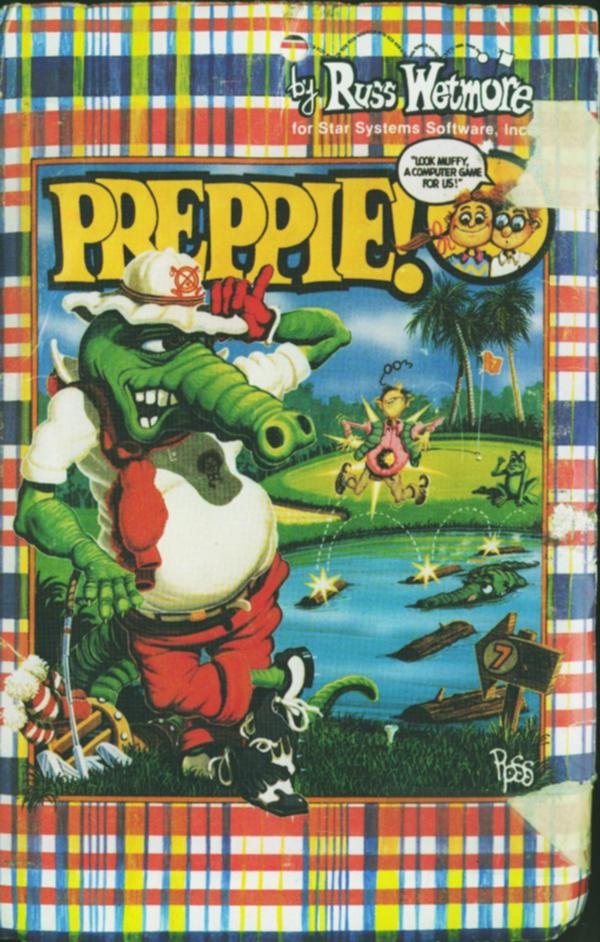
Preppie
I had this on cassette for my a8 and spent many happy hours in front of the Radio Rentals BAIRD 19 inch colour telly that we had in the family living room waggling my stick thereto. This is perhaps surprising as the game is based on Frogger and I’ve never been an especially huge fan of Frogger. Not even the prospect of lady frog action can hold my attention for more than a few goes of that I’m afraid.

19 inches of 70stastic glory. I don’t think this one caught fire.
For all that the gameplay is basically Frogger though, Preppie is so nicely dressed up that I can forgive it that and enjoy persevering through quite a few levels. A “preppie”, apparently, is the kind of American college student who is far too rich by dint of having rich parents. They like to wear Lacoste shirts (remember those, with the little alligator on them? I vaguely remember those being a thing in the 80s) and are generally a bit annoying, apparently. In this game you are one of these “preppies” by the name of Wadsworth Overcash (I SEE WHAT YOU DID THERE) and for some reason you have to collect balls on a golf course (because golf is a preppie kind of game to be playing apparently). Anyway.

Basically it’s Frogger isn’t it.
Yes, basically it is Frogger, but there’s at least a little humour in it and the music’s rather good. It starts out pretty gentle and easy but the time limit in particular becomes a lot shorter on higher levels where you have several balls to pick up.

Here we are on level 5 with three balls to collect and Lacoste alligators to mount.
As far as Froggers go this is one of the nicest on the a8, and very nicely made as are all the games on the platform by Mr. Wetmore (I wonder if he’s ever been to Wetwang in the Yorkshire Wolds? Probably not). His next though is a little more interesting as it departs (mostly) from being so basically Frogger.

In this outing Wadsworth Overcash is back and for some reason is tasked with painting the floors of a maze pink.

Pinken that maze Wadsworth.
To be honest I think he looks more like a footballer here than a rich American college student but I guess there’s only so much you can do with player/missile graphics. The giant frogs from the first game are back (they appear in the median strip of that game after a few levels) and these lollop in a fairly leisurely fashion around two of the three interconnected mazes. There are a couple of turnstile-doors like in Lady Bug that you can use to thwart their relentless advances, and just like a real rich person you can make yourself visually and corporially imperceptible with a press of the fire button, allowing you to pass straight through your slimy pursuers like a bad lunch. Naturally this power isn’t unlimited and you must use it sparingly in order successfully to pinken all three mazes.
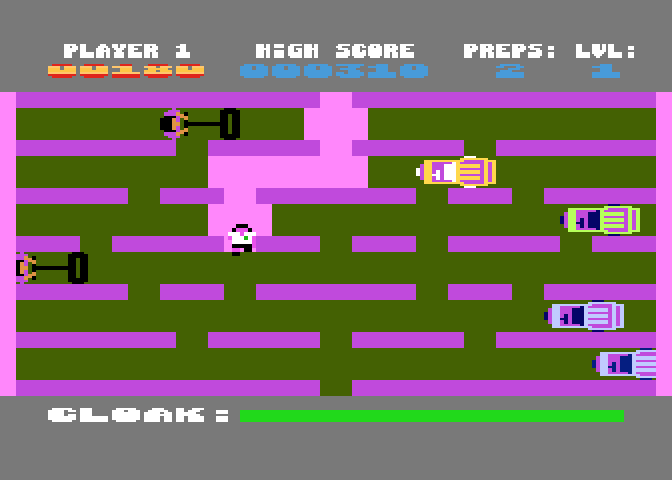
The second of the three mazes.
In the second maze of the three there are no giant frogs; instead there is a reprise of some of the elements from the first game in the shape of golf carts and lawnmowers. Beware as although there can only be one of each in each corridor at a time, they can emerge from either side, making painting the corridor ends somewhat of a bugger if you’re not careful.
Another jolly nice game from Mr. Wetmore then, again excellently programmed and with nice jolly music, rather more interesting than the first in that it incorporates elements of the painting and maze genres as well as a slight remaining whiff of Frogger. I can’t remember if cats come out and leave paw prints in your pink paint on higher levels or if I’m just imagining that. If they don’t then they ought to.
Russ Wetmore also did a game called Sea Dragon which is a port of a game originally infinitely uglier on the TRS-80.
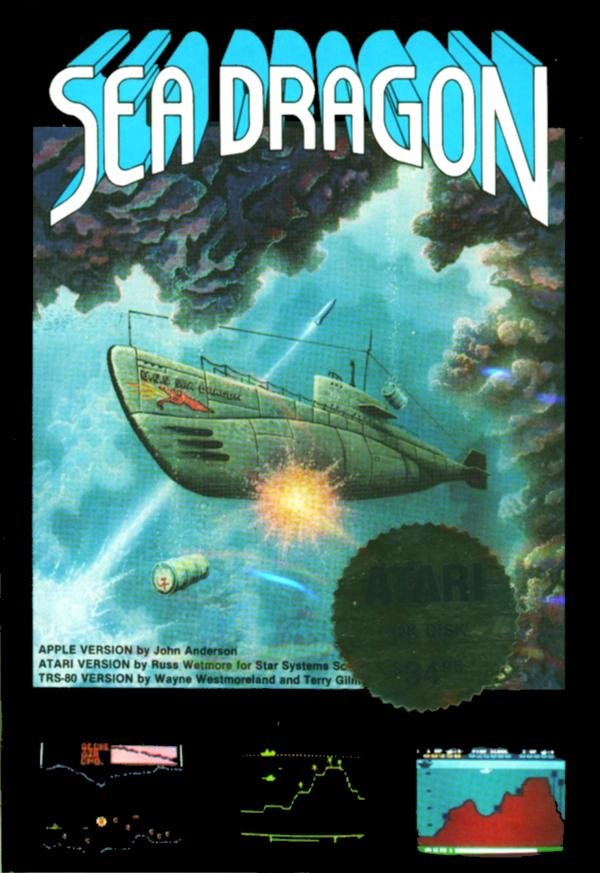
The game itself can be pretty much summed up as “Scramble with a submarine”.
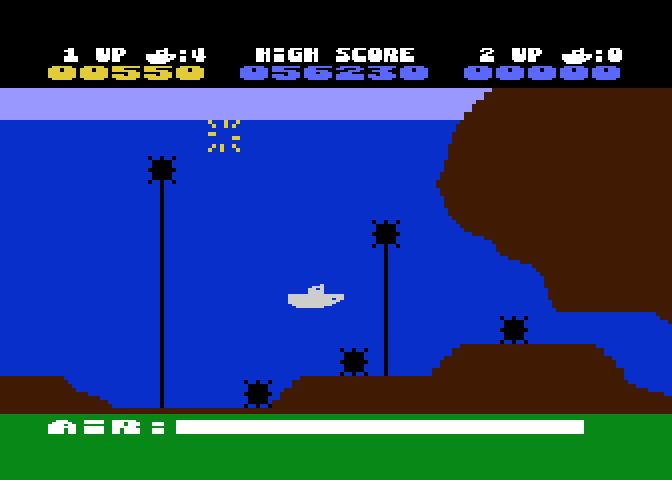
Scramble with a submarine.
It’s considerably slower than arcade Scramble, and you might think that’ll work to your advantage but trust me, it really doesn’t. This game is harder than a drunken Scotsman. You will die and swear a few times even on the first, relatively easy bit where you are just shooting the mines. Once you get into the twisty little caverns (which are immediately about as hard to navigate through as the last parts of arcade Scramble, necessitating those kind of turns where you have to haul back on the stick just to scrape through, and there are bastard lasers) good luck.
William Mataga
You might have seen some of these games ported to the Commodore 64 but they originated on the A8 (in fact I plan at some point to do a blog entry along the theme of “Games whose A8 Versions are the Original and Best“, which is actually quite a large category containing some famous names). We’ll start with one of my favourite A8 games from back in the day:
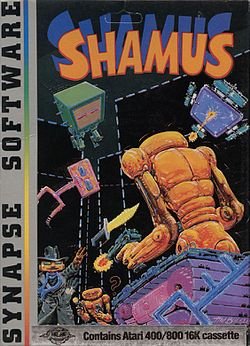
Apparently “shamus” is American slang for a private eye. I did not know that. The only Shamus I knew at that time was the dog out of Meddle by Pink Floyd.
I had this on cassette tape for my Atari 400 before I got posh and bought an 800 with a disk drive. You could actually hear the data as the game loaded; it sounded something like the ringing tone of an American telephone. Still took bloody ages to load though. However did we all put up with tape decks for so long? (Mind you, back in those days when you’d actually paid a decent price for a game and waited ten minutes for it to load, you damn well took your time to learn to play that game well, despite how much more difficult many games were back then. Having invested a not inconsiderable amount of money and time to get that game into your machine you were damn well going to persevere for a bit before switching it off).
Anyway, sitting through the bleeps and burps was well worth it.
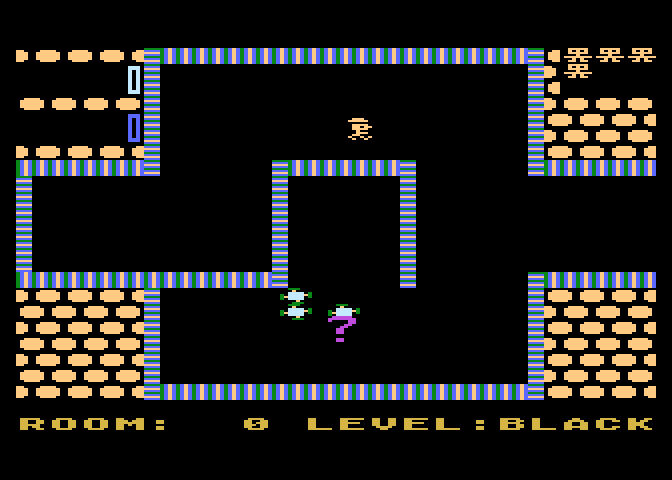
May not look like much but it was in fact challenging and fun.
Granted the graphics don’t look like that much, and the colours aren’t quite as lovely as they can be in a lot of A8 games, but the gameplay was strong and challenging. It’s basically faster Berzerk with some actual purposeful exploration bolted on. Rooms could contain treasures as well as monsters, and there were variously coloured keys to be found which opened up new parts of the maze and eventually whole new levels.
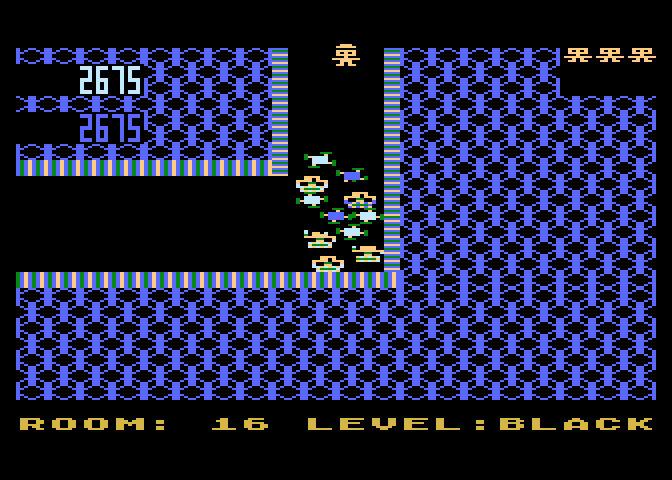
The enemies look like they belong in one of those peculiar childrens’ breakfast cereals.
Notice the line between the little man’s head and his hat – bullets will pass straight through that without harming you, just like the same thing with the player’s neck in Berzerk. Also like in Berzerk spending too long in a room will lead to an indestructible enemy appearing and chasing you out of the room. Gameplay overall is a good bit faster than Berzerk though – not quite up to Robotron standards but pretty quick on the later levels. There’s nice little touches throughout like the fact that if you die for the next couple of rooms the enemies are a little bit less aggressive, giving you a little breathing space for you to recover from your loss. Nice.
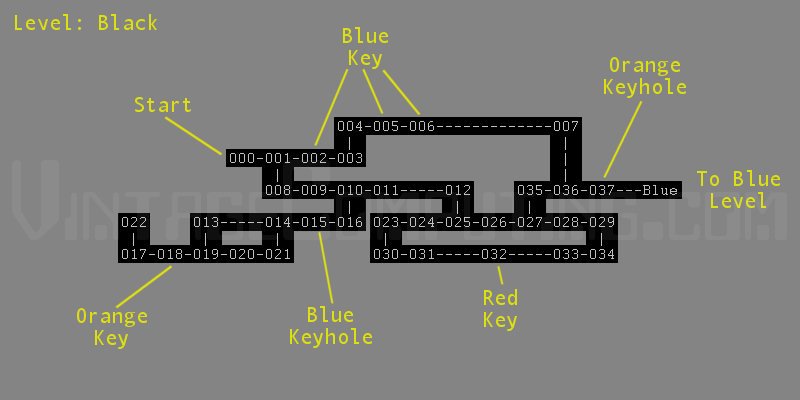
Map of the first level. There are four in total.
A jolly nice game, and one which scratches a nice little itch between fast-paced arena violence and exploration. In fact I think there’s still room for more of this type of thing to this day – straight arena shooters have been done to death by now I think, but something like this done in a Robotron style is something I could play the hell out of even now.
Mataga did a sequel to Shamus:
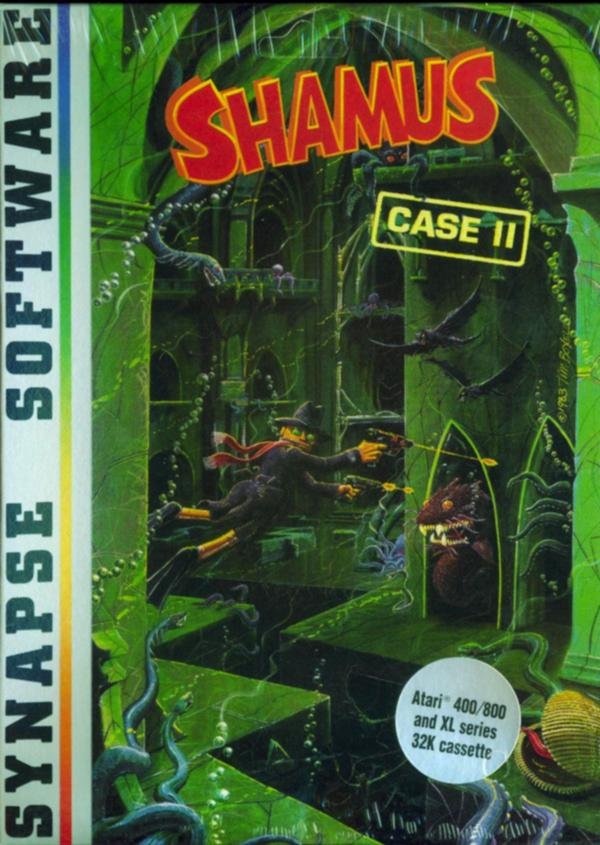
which is kind of interesting but IMO not such a good game as its ancestor.
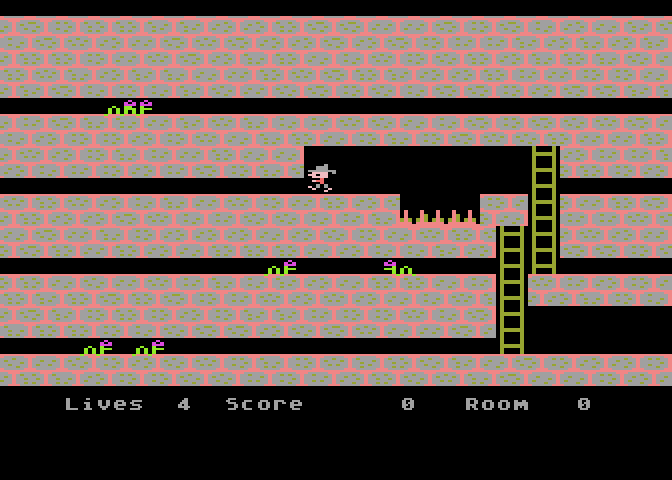
The first kind of screen.
Play alternates between two different kinds of screen. In this first kind you can move around the chambers and ladders, jumping over the pits and avoiding the snakes that come through all the snake delivery tubes that cross the level. It sort of looks a bit like Montezuma’s Revenge (another excellent game I’ll get to in a future update) but it’s really not.
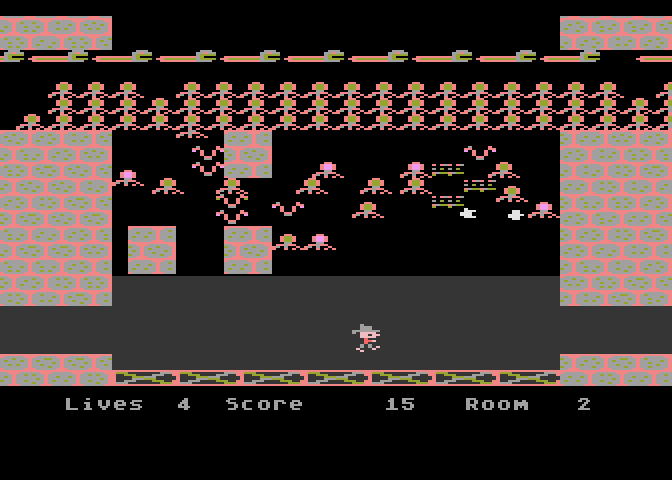
The second kind of screen.
On this second kind of screen you can shoot projectiles upwards into the teeming masses of thingummajigs, some of which come down and try to get you. You have to knock out all of the pacman-snake-things at the top to move to the next bit. There’s something to do with a bird that is supposed to be your ally but which nonetheless attacks you and needs shot, and every now and again the indestructible enemy from the first game appears and attacks you. It’s all a little bit confusing to be honest, and I don’t fully understand all of it yet despite having read the manual. Definitely more complex than the basic “you, gun, baddies, maze” of the original. Still, quite a lot of people seem to like it, and I fully admit I haven’t played it much so it could be I’ve just not given it a fair chance yet. I’ll have a few more goes and see. As of this moment I still prefer the original Shamus by far.
Finally let’s have a look at Mataga’s final release on the A8, “Zeppelin”.
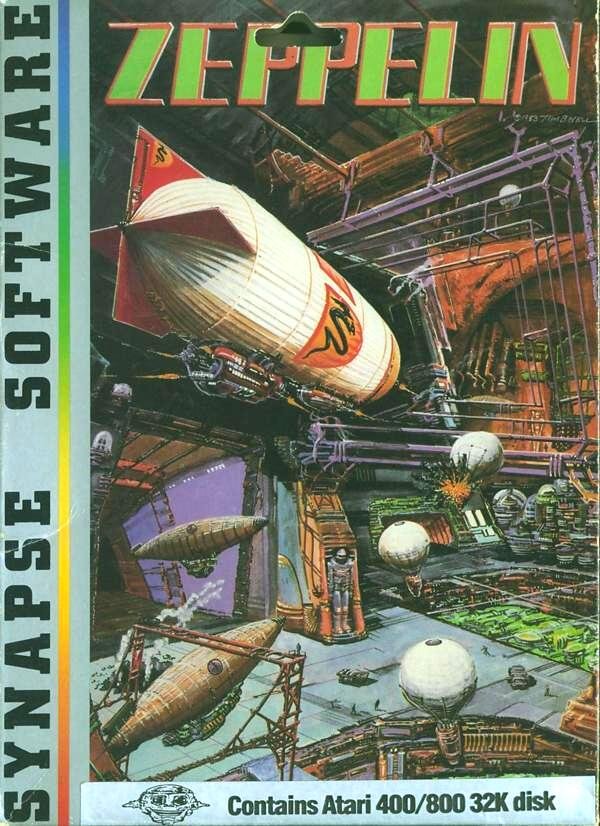
Continuing the videogame tradition of subterranean aviation.
In this multidirectionally scrolling shooter you get to fly a dirigible through a cave. Cave-based aviation seemed like quite a popular theme for 80s videogames, with the likes of Fort Apocalypse having you pilot a helicopter through subterranean caverns, and Looping having you fly a small, acrobatic prop plane through various cave-like structures. Not to mention Scramble and Caverns of Mars.
Anyway.
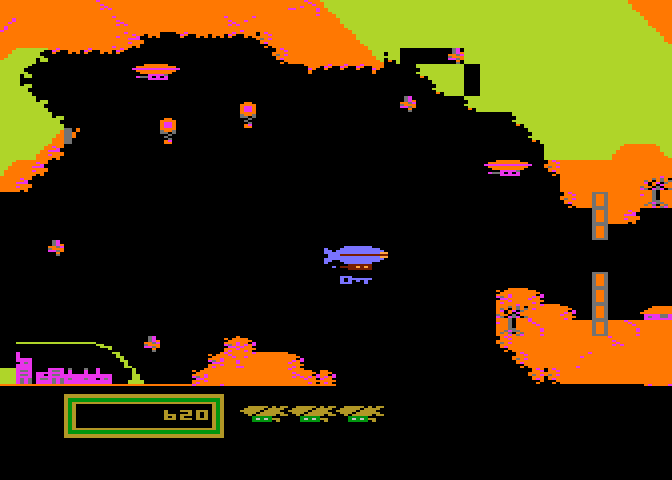
Flying through the caverns.
OK it looks a bit of a dog’s breakfast in the screenshot bit it’s actually not too bad when you’re playing. The terrain scrolls past smoothly in whatever direction you’re going. There are switches to shoot which turn on or off various defences, little balloons to shoot, and factories under domes that you get to wreck as you pass by. By moving your zeppelin to different parts of the screen you can kind of choose which direction the scrolling will go next and therefore where you will end up going. There are some parts of the cavern that are locked and which require you to pick up an absolutely enormous key, almost as big as a bungalow, and bring it to an equally gigantic lock by carrying it underneath your zeppelin.
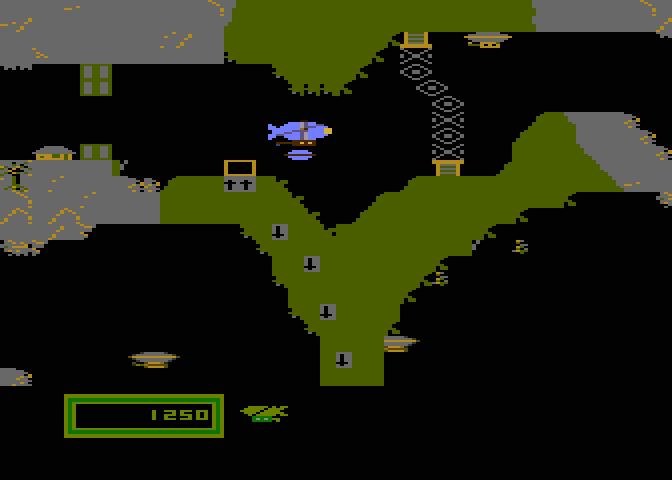
Nice little bungalows can be found throughout the caverns.
There are more factories under glass domes which you get bonus points for fucking up, and nice little bungalows everywhere that you get to ruin. Some switches are guarded by a monster that likes hamburgers, so you have to find a giant hamburger almost as big as a bungalow and bring it to said monsters to distract them. To progress to the next level you have to find a box of TNT almost as big as a bungalow, shoot an absolutely gigantic plunger to make it go up, deposit the TNT into the box, and then shoot the plunger, itself almost as big as a zeppelin, in order to progress to the next level.
I love 1980s game logic. It’s like being stoned without having to actually smoke any weed.
Where are they now?
Russ Wetmore stopped making games after the three mentioned here and went on to develop business and productivity software. Still coding, according to the info about him on Wikipedia. Excellently enough he recently released the source code for all three games on archive.org.
William Mataga is now Cathryn Mataga and appears to have had a productive career in the games biz since those early 8-bit days. You’ve probably played some of the games she’s worked on.
Right that’s it for this week. I’ll be doing more Atarians of Note in the future and I have a few other themed entries I’m going to do, all still centered round the A8, and all of which will featire games well worth firing up on the emulator. Do play along ![]() .
.
And finally…
From December 1982, A8 public domain.

Sounds familiar…











